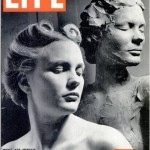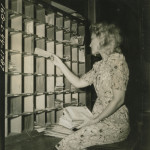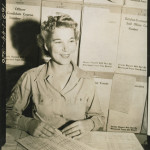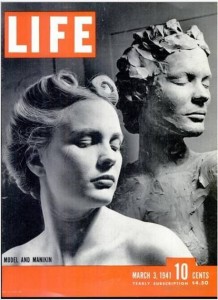Home Front Friday: New Year New ‘Do
Home Front Friday is a regular series that highlights the can do spirit on the Home Front during World War II and illustrates how that spirit is still alive today!
It’s a new year, and while we’re making resolutions and plans for a successful 2015, why not consider trying something different with your hair? Take a tip from the women of the 1940s who could set a pin curl like it was nobody’s business. They found a way to look elegant no matter what they were doing – from nursing on the front lines to operating machinery on the home front. Whatever occasion, the vintage hairstyles popularized during WWII will bring a casual yet sophisticated look to this new year!
- cover of March 3, 1941 LIFE magazine
- Margaret D. Bailey sorting mail at the Army Post Office, Fort Benning, Georgia on 12 July 1944
- Close up portrait of a civilian woman on a California beach during World War II
- The 1st WAC to hold the rank of Master Sgt. at Fort Benning, Georgia on 14 July 1944
There were multiple hairstyles during this period, that women wore whether in service, at work or at play, and you can easily recreate any of them using Lauren Rennells’s book, Vintage Hairstyling. For now, we’d love to share Rennells’s eleven simple steps to creating Victory Rolls!
This style is said to get its name from the exhaust trails left from WWII fighter plane maneuvers. Essentially, anytime hair is rolled up with a visible opening, it is a victory roll. It was useful to keep hair out of women’s faces when they entered the work force. Due to the rationing, women pulled this look off with pipe cleaners decades ago, but you won’t have to do that!
Things You’ll Need:
- Hot rollers and clips
- Thermal spray
- Styling comb of choice
- Styling brush
- Bobby pins
- Hairspray
- Pomade
Step 1: Set the hair in hot rollers and let cool. Hair can be slippery and if hair is too fine, the rolls may look skimpy. For this reason, back brushing or teasing is helpful. It adds locking power to the roll and fullness for high impact. Hold the entire piece that will be rolled up in the direction it will be rolled. Use a brush or comb to tease gently.
Step 2: Then use a comb to smooth out the hair that will be on the outside of the roll. Spray a little hairspray on the hair to hold on to what was just formed.
Step 3: This is where the bend from the hot rollers comes in handy. Allow the ends that now curl to curl into themselves.
Step 4: This style works nicely when the ends of the hair are actually hidden inside the roll. It creates support in the style and staying power.
Step 5: Hide large bobby pins inside the roll to attach to the hair at the scalp.
Step 6: The victory roll can be made any size. Traditionally, it sits on top of the head facing forward, but experiment with different directions and placement. See the Final Styles section of the book for creative things to do with victory rolls.
Step 7 & 8: If it is not desired to see through the roll, gently insert a comb at the side of the roll and shift the hair back until the side of the roll is lying flag against the hair.
Step 9: Insert a couple of small bobby pins where the hair has been pressed against the head to hold a beautiful swoop.
Step 10: Victory rolls can be created with any amount of hair desired. For this demonstration, very large pieces have been used, but breaking it up into smaller, more manageable pieces makes for good practice.
Step 11: The second section of hair is rolled back, but held at a diagonal to center the roll. Also experiment with the direction that the section of hair is pulled to achieve different placement. Notice the first roll was pulled straight up for its base placement.
If you like the classic and beautiful hairstyles of the 40’s and 50’s, try this (or another style) out for yourself and start 2015 with a bang (pun intended)!
Posted by Laurel Taylor, Education Intern and Lauren Handley, Assistant Director of Education for Public Programs at The National WWII Museum.
- Posted :
- Post Category :
- Tags : Tags: Home Front
- Follow responses to this entry through the RSS 2.0 feed. You can skip to the end and leave a response. Pinging is currently not allowed.









Leave a Reply